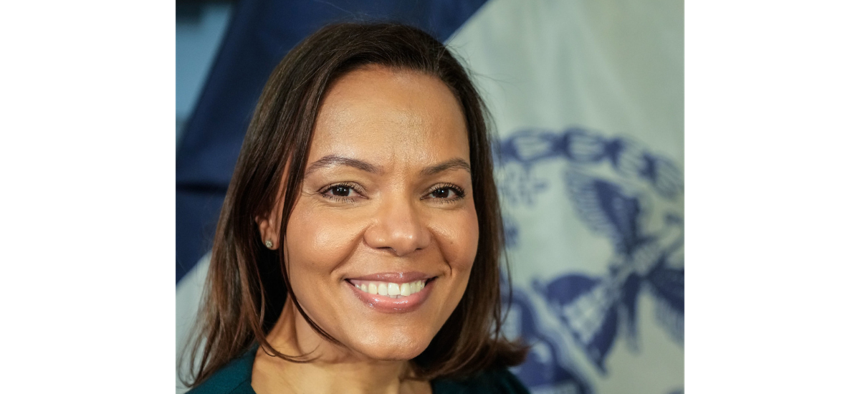Opinion
Opinion: Latinos make up 22% of new hires within Adams administration, 2% more than de Blasio, but it’s not enough
City Hall’s latest workforce report filed with the federal Equal Employment Opportunity Commission shows how a historical hiring bias has been slow to reverse.

New York City Mayor Eric Adams announces the appointment of Ana Almanzar as deputy mayor for strategic initiatives at City Hall on May 26, 2023. Michael Appleton/Mayoral Photography Office
A historical hiring bias in City Hall continues under Mayor Eric Adams. In New York City, Latinos, the second largest population group after whites, continue to rank third or fourth among new hires at City Hall raising concerns about fairness and opportunities.
According to the latest City Hall workforce report filed with the federal Equal Employment Opportunity Commission, Latinos make up only 22% of new hires under Adams’s first full fiscal year. This is a 2% increase from the de Blasio administration, but still falls far behind the representation of white (32%) and Black (26%) New Yorkers.
New York City’s population is 37.5% white, 29% Latino, 23% African-American, and 14% Asian, according to the U.S. Census. And the percentage of Latinos and Asians is growing fast. Latinos are predicted to represent a plurality of New Yorkers by midcentury. Meanwhile, 3,000 white people and 84,000 African-Americans moved out of the city.
Among the goals of the civil rights and union movements were equitable access to employment with benefits like health care and retirement plans and access to mortgages. This is crucial for all communities. While fostering diverse voices in decision-making processes ensures fairer resource allocation. This continued hiring bias in City Hall hurts the Latino community.
This is critical. A third of the city’s population under 18 years of age is Latino. More than half live in childhood poverty, according to the UCLA Latino Policy and Politics Institute. Statistically, they are likely to grow into adult poverty if they don’t have advocates in City Hall working towards solutions to lift them out of poverty.
“The traditional path out of intergenerational, concentrated poverty is steady employment. By the sheer numbers, one would think Latinos would be doing much better getting jobs with the largest employer in the five boroughs: the City of New York.”
I wrote that here at City & State in 2017 and it still holds true today.
Furthermore, Latinos played a critical role in Mayor Adams’s electoral victory making their underrepresentation among new hires a potential concern for future political support. It was a shock when out of the gate he did not include a Latino among his deputy mayors. It took him nearly a year-and-a-half to correct this grievous error with the appointment of Ana Almanzar, who is from the Dominican Republic, as deputy mayor for strategic initiatives.
A City Hall spokesperson said: “Having equal and fair representation in the hiring of staff at City Hall is, and will continue to be, a priority for this administration, as we work to ensure city government looks like New York City. While we have made great progress — significantly increasing and even double the pace of hiring Latino New Yorkers in certain titles with Latino leaders serving in some of the highest-ranking positions in city government — there is still more work to be done.”
A deep dive into the city’s 38-page EEO-4 report filed by the Dept. of Citywide Administrative Services reveals persistent disparities in hiring at different levels. Among top City Hall appointees, Latinos rank third in hiring with only 16%, according to the workforce report. Meanwhile, whites still rank first with 50% and Blacks come in second at 20%. Asians rank fourth at 12%.
The bias in hiring is even more pronounced at the next level down, among the professionals who are gaining experience and seniority to move up the city’s career ladder. Whites are again in the first position with 26%. Asians, for the first time, leapfrog Blacks to gain position with 25%, pushing blacks down a peg to third at 20%, and Latinos down to fourth place with 17% of new professional hires.
Let’s drill down to the most critical issues today: poverty and housing.
At the city’s anti-poverty or poverty amelioration agencies, Administration for Children’s Services, Department of Social Services, Dept. of Homeless Services, Human Resources Administration, and the Dept of Youth and Community Development the number of new hires are even more lopsided.
African-Americans represent 55% of new hires. Latinos 19%. Whites 10%. And Asians 14%.
The same goes for Housing Preservation and Development and the Department of Buildings.
African-Americans represent 34% of new hires, whites represent 24%, Latinos 20%, and Asians 18%.
Addressing systemic bias and achieving equitable representation require sustained effort and comprehensive strategies. Highlighting the data and its implications is a crucial step in holding institutions accountable and driving progress towards a more inclusive workforce.
Borges writes about race and poverty. His email is edwardborges@gmail.com.
NEXT STORY: Editor’s note: A safety concern on the Manhattan side of the Brooklyn Bridge is allowed to continue

